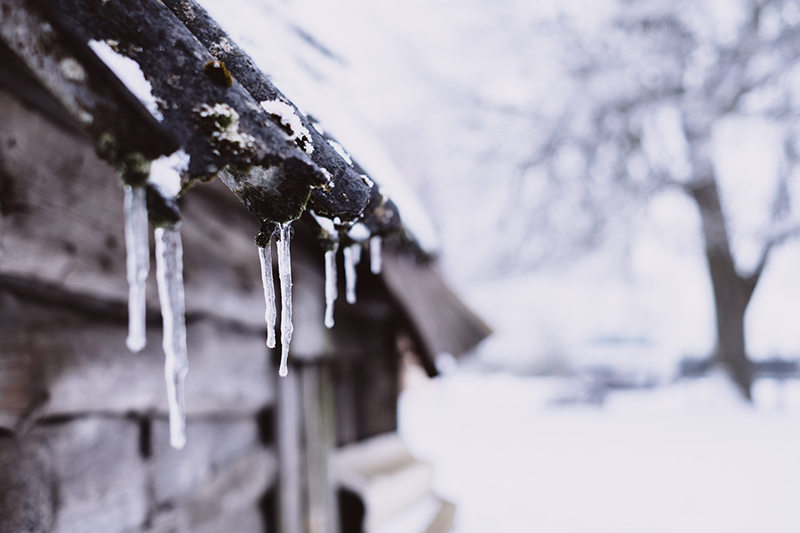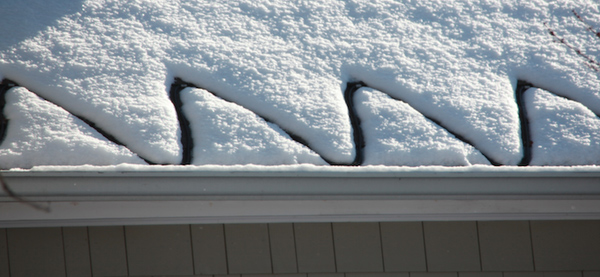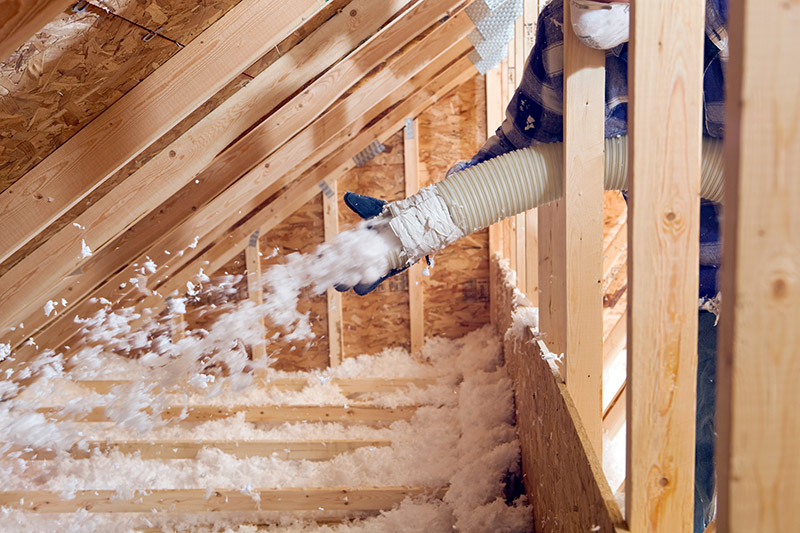
Dear Eartha,
I have massive ice dams building up on my roof. How important is it that I take care of these? – Terry, Summit Cove
 We’ve been hearing quite a bit about ice dams this winter from a number of Summit County residents. In fact, I’m especially qualified to respond to your ice dam inquiry as I too am in the throes of an ice dam war. Often considered to be an unavoidable staple of winter dwelling in our mountain community, ice dams have a reputation for being that building concern we tend to avoid addressing.
It’s important to first understand that ice dams do not have to be a mandatory adornment on your mountain home. Secondly, ice dams are a serious building concern that should either be mitigated or addressed at their root cause. Much like an effective medical practitioner, energy analysts and building scientists would agree that the proper way to address an issue is to solve the core problem.
Many contractors will turn to de-icing cable, often referred to as heat tape, to solve this symptom. Installing several hundred feet of de-icing cable on the lower sections of your roof, these contractors seem to have saved the day. This holds true for most, until they see their utility bill. The harsh truth about de-icing cable is that it uses a lot of electricity — about 6 watts per foot at 32˚ and even more at lower temperatures. If 100 linear feet of cable is utilized for six months of the year, it will consume more than 2,600 KWh of electricity at a cost of $300. For this reason, in addition to it being a mere symptom fix, we cannot in good conscious recommend installing de-icing cable.
We’ve been hearing quite a bit about ice dams this winter from a number of Summit County residents. In fact, I’m especially qualified to respond to your ice dam inquiry as I too am in the throes of an ice dam war. Often considered to be an unavoidable staple of winter dwelling in our mountain community, ice dams have a reputation for being that building concern we tend to avoid addressing.
It’s important to first understand that ice dams do not have to be a mandatory adornment on your mountain home. Secondly, ice dams are a serious building concern that should either be mitigated or addressed at their root cause. Much like an effective medical practitioner, energy analysts and building scientists would agree that the proper way to address an issue is to solve the core problem.
Many contractors will turn to de-icing cable, often referred to as heat tape, to solve this symptom. Installing several hundred feet of de-icing cable on the lower sections of your roof, these contractors seem to have saved the day. This holds true for most, until they see their utility bill. The harsh truth about de-icing cable is that it uses a lot of electricity — about 6 watts per foot at 32˚ and even more at lower temperatures. If 100 linear feet of cable is utilized for six months of the year, it will consume more than 2,600 KWh of electricity at a cost of $300. For this reason, in addition to it being a mere symptom fix, we cannot in good conscious recommend installing de-icing cable.
 There are two actions that cause snow to melt on roofs. The primary action is caused when indoor heat is lost through the attic or vaulted ceiling space causing snow to regularly melt on the roofing surface. This process creates water which travels down the roofing surface. When this migrating water reaches the eave (the exposed, cantilevered section of roof extending beyond the exterior walls) it is no longer exposed to the indoor heat loss from below. At the eave, the water refreezes, creating an ice dam that can trap water behind it. As these dams grow, icicles begin to form from excessive water flowing up over the dam. Water that remains trapped behind the dam may penetrate the roof and manifest as a leak within your home.
The secondary action that causes snow to melt on roofs is sunlight and warmer temperatures. This action however typically affects the entire roof area including the eave, and is less likely to create an ice dam, unless of course, an ice dam is already present. The proper solution to the core cause of ice dams is to reduce indoor heat loss through your roof. We recommend improving your attic or vaulted ceiling insulation so that on-the-roof de-icing cables may no longer be needed. What we are after is achieving a roof temperature that matches the outdoor temperature at all times. If you have cathedral or vaulted ceilings in your home, the solution remains the same. Ventilation baffles should be installed in your vaulted roofs, conducting outdoor airflow across the underside of your roof sheathing. Then we like to dense pack the vaulted ceiling with insulation until the cavity is full.
There are two actions that cause snow to melt on roofs. The primary action is caused when indoor heat is lost through the attic or vaulted ceiling space causing snow to regularly melt on the roofing surface. This process creates water which travels down the roofing surface. When this migrating water reaches the eave (the exposed, cantilevered section of roof extending beyond the exterior walls) it is no longer exposed to the indoor heat loss from below. At the eave, the water refreezes, creating an ice dam that can trap water behind it. As these dams grow, icicles begin to form from excessive water flowing up over the dam. Water that remains trapped behind the dam may penetrate the roof and manifest as a leak within your home.
The secondary action that causes snow to melt on roofs is sunlight and warmer temperatures. This action however typically affects the entire roof area including the eave, and is less likely to create an ice dam, unless of course, an ice dam is already present. The proper solution to the core cause of ice dams is to reduce indoor heat loss through your roof. We recommend improving your attic or vaulted ceiling insulation so that on-the-roof de-icing cables may no longer be needed. What we are after is achieving a roof temperature that matches the outdoor temperature at all times. If you have cathedral or vaulted ceilings in your home, the solution remains the same. Ventilation baffles should be installed in your vaulted roofs, conducting outdoor airflow across the underside of your roof sheathing. Then we like to dense pack the vaulted ceiling with insulation until the cavity is full.
 If you must use de-icing cable for safety reasons, consider installing a timer to run the heat tape from 6a.m. to 6p.m. and only when there is snow on the roof. It may seem counter-intuitive, but the best time to run heat tape is during the day when it’s sunny and the temperature is above 32˚.
If you’re seriously considering an energy efficiency improvement for your home, or even if you want to learn more about what can be done to reduce the ice dams on your home, you should start with an energy audit of your property. Have a certified building analyst audit your home for both potential safety concerns and energy efficiency. Visit EnergySmartColorado.com to request a home energy audit at your property. You’ll receive a comprehensive report outlining areas for potential improvement as well as expected annual savings.
Ask Eartha Steward is written by the staff at the High Country Conservation Center. Submit questions to Eartha at info@highcountryconservation.org.
If you must use de-icing cable for safety reasons, consider installing a timer to run the heat tape from 6a.m. to 6p.m. and only when there is snow on the roof. It may seem counter-intuitive, but the best time to run heat tape is during the day when it’s sunny and the temperature is above 32˚.
If you’re seriously considering an energy efficiency improvement for your home, or even if you want to learn more about what can be done to reduce the ice dams on your home, you should start with an energy audit of your property. Have a certified building analyst audit your home for both potential safety concerns and energy efficiency. Visit EnergySmartColorado.com to request a home energy audit at your property. You’ll receive a comprehensive report outlining areas for potential improvement as well as expected annual savings.
Ask Eartha Steward is written by the staff at the High Country Conservation Center. Submit questions to Eartha at info@highcountryconservation.org.
 We’ve been hearing quite a bit about ice dams this winter from a number of Summit County residents. In fact, I’m especially qualified to respond to your ice dam inquiry as I too am in the throes of an ice dam war. Often considered to be an unavoidable staple of winter dwelling in our mountain community, ice dams have a reputation for being that building concern we tend to avoid addressing.
It’s important to first understand that ice dams do not have to be a mandatory adornment on your mountain home. Secondly, ice dams are a serious building concern that should either be mitigated or addressed at their root cause. Much like an effective medical practitioner, energy analysts and building scientists would agree that the proper way to address an issue is to solve the core problem.
Many contractors will turn to de-icing cable, often referred to as heat tape, to solve this symptom. Installing several hundred feet of de-icing cable on the lower sections of your roof, these contractors seem to have saved the day. This holds true for most, until they see their utility bill. The harsh truth about de-icing cable is that it uses a lot of electricity — about 6 watts per foot at 32˚ and even more at lower temperatures. If 100 linear feet of cable is utilized for six months of the year, it will consume more than 2,600 KWh of electricity at a cost of $300. For this reason, in addition to it being a mere symptom fix, we cannot in good conscious recommend installing de-icing cable.
We’ve been hearing quite a bit about ice dams this winter from a number of Summit County residents. In fact, I’m especially qualified to respond to your ice dam inquiry as I too am in the throes of an ice dam war. Often considered to be an unavoidable staple of winter dwelling in our mountain community, ice dams have a reputation for being that building concern we tend to avoid addressing.
It’s important to first understand that ice dams do not have to be a mandatory adornment on your mountain home. Secondly, ice dams are a serious building concern that should either be mitigated or addressed at their root cause. Much like an effective medical practitioner, energy analysts and building scientists would agree that the proper way to address an issue is to solve the core problem.
Many contractors will turn to de-icing cable, often referred to as heat tape, to solve this symptom. Installing several hundred feet of de-icing cable on the lower sections of your roof, these contractors seem to have saved the day. This holds true for most, until they see their utility bill. The harsh truth about de-icing cable is that it uses a lot of electricity — about 6 watts per foot at 32˚ and even more at lower temperatures. If 100 linear feet of cable is utilized for six months of the year, it will consume more than 2,600 KWh of electricity at a cost of $300. For this reason, in addition to it being a mere symptom fix, we cannot in good conscious recommend installing de-icing cable.
 There are two actions that cause snow to melt on roofs. The primary action is caused when indoor heat is lost through the attic or vaulted ceiling space causing snow to regularly melt on the roofing surface. This process creates water which travels down the roofing surface. When this migrating water reaches the eave (the exposed, cantilevered section of roof extending beyond the exterior walls) it is no longer exposed to the indoor heat loss from below. At the eave, the water refreezes, creating an ice dam that can trap water behind it. As these dams grow, icicles begin to form from excessive water flowing up over the dam. Water that remains trapped behind the dam may penetrate the roof and manifest as a leak within your home.
The secondary action that causes snow to melt on roofs is sunlight and warmer temperatures. This action however typically affects the entire roof area including the eave, and is less likely to create an ice dam, unless of course, an ice dam is already present. The proper solution to the core cause of ice dams is to reduce indoor heat loss through your roof. We recommend improving your attic or vaulted ceiling insulation so that on-the-roof de-icing cables may no longer be needed. What we are after is achieving a roof temperature that matches the outdoor temperature at all times. If you have cathedral or vaulted ceilings in your home, the solution remains the same. Ventilation baffles should be installed in your vaulted roofs, conducting outdoor airflow across the underside of your roof sheathing. Then we like to dense pack the vaulted ceiling with insulation until the cavity is full.
There are two actions that cause snow to melt on roofs. The primary action is caused when indoor heat is lost through the attic or vaulted ceiling space causing snow to regularly melt on the roofing surface. This process creates water which travels down the roofing surface. When this migrating water reaches the eave (the exposed, cantilevered section of roof extending beyond the exterior walls) it is no longer exposed to the indoor heat loss from below. At the eave, the water refreezes, creating an ice dam that can trap water behind it. As these dams grow, icicles begin to form from excessive water flowing up over the dam. Water that remains trapped behind the dam may penetrate the roof and manifest as a leak within your home.
The secondary action that causes snow to melt on roofs is sunlight and warmer temperatures. This action however typically affects the entire roof area including the eave, and is less likely to create an ice dam, unless of course, an ice dam is already present. The proper solution to the core cause of ice dams is to reduce indoor heat loss through your roof. We recommend improving your attic or vaulted ceiling insulation so that on-the-roof de-icing cables may no longer be needed. What we are after is achieving a roof temperature that matches the outdoor temperature at all times. If you have cathedral or vaulted ceilings in your home, the solution remains the same. Ventilation baffles should be installed in your vaulted roofs, conducting outdoor airflow across the underside of your roof sheathing. Then we like to dense pack the vaulted ceiling with insulation until the cavity is full.
 If you must use de-icing cable for safety reasons, consider installing a timer to run the heat tape from 6a.m. to 6p.m. and only when there is snow on the roof. It may seem counter-intuitive, but the best time to run heat tape is during the day when it’s sunny and the temperature is above 32˚.
If you’re seriously considering an energy efficiency improvement for your home, or even if you want to learn more about what can be done to reduce the ice dams on your home, you should start with an energy audit of your property. Have a certified building analyst audit your home for both potential safety concerns and energy efficiency. Visit EnergySmartColorado.com to request a home energy audit at your property. You’ll receive a comprehensive report outlining areas for potential improvement as well as expected annual savings.
Ask Eartha Steward is written by the staff at the High Country Conservation Center. Submit questions to Eartha at info@highcountryconservation.org.
If you must use de-icing cable for safety reasons, consider installing a timer to run the heat tape from 6a.m. to 6p.m. and only when there is snow on the roof. It may seem counter-intuitive, but the best time to run heat tape is during the day when it’s sunny and the temperature is above 32˚.
If you’re seriously considering an energy efficiency improvement for your home, or even if you want to learn more about what can be done to reduce the ice dams on your home, you should start with an energy audit of your property. Have a certified building analyst audit your home for both potential safety concerns and energy efficiency. Visit EnergySmartColorado.com to request a home energy audit at your property. You’ll receive a comprehensive report outlining areas for potential improvement as well as expected annual savings.
Ask Eartha Steward is written by the staff at the High Country Conservation Center. Submit questions to Eartha at info@highcountryconservation.org.
